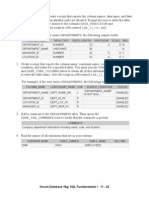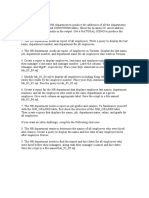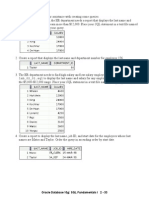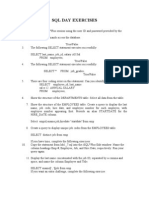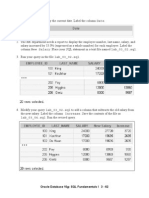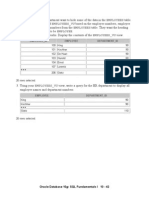SQL Fundamentals - Practice 04
Uploaded by
Abby ARSQL Fundamentals - Practice 04
Uploaded by
Abby ARPractice 4
Determine the validity of the following three statements. Circle either True or False.
1. Group functions work across many rows to produce one result per group.
True/False
2. Group functions include nulls in calculations.
True/False
3. The WHERE clause restricts rows before inclusion in a group calculation.
True/False
The HR department needs the following reports:
4. Find the highest, lowest, sum, and average salary of all employees. Label the columns
Maximum, Minimum, Sum, and Average, respectively. Round your results to the
nearest whole number. Place your SQL statement in a text file named lab_04_04.sql.
5. Modify the query in lab_04_04.sql to display the minimum, maximum, sum, and
average salary for each job type. Resave lab_04_04.sql as lab_04_05.sql. Run
the statement in lab_04_05.sql.
Oracle Database 10g: SQL Fundamentals I 4 - 26
Practice 4 (continued)
6. Write a query to display the number of people with the same job.
Generalize the query so that the user in the HR department is prompted for a job title. Save
the script to a file named lab_04_06.sql.
7. Determine the number of managers without listing them. Label the column Number of
Managers. Hint: Use the MANAGER_ID column to determine the number of managers.
8. Find the difference between the highest and lowest salaries. Label the column
DIFFERENCE.
If you have time, complete the following exercises:
9. Create a report to display the manager number and the salary of the lowest-paid employee
for that manager. Exclude anyone whose manager is not known. Exclude any groups where
the minimum salary is $6,000 or less. Sort the output in descending order of salary.
Oracle Database 10g: SQL Fundamentals I 4 - 27
Practice 4 (continued)
If you want an extra challenge, complete the following exercises:
10. Create a query to display the total number of employees and, of that total, the number of
employees hired in 1995, 1996, 1997, and 1998. Create appropriate column headings.
11. Create a matrix query to display the job, the salary for that job based on department
number, and the total salary for that job, for departments 20, 50, 80, and 90, giving each
column an appropriate heading.
Oracle Database 10g: SQL Fundamentals I 4 - 28
You might also like
- Practica 1 - Oracle Database 11g SQL Fundamentals I100% (1)Practica 1 - Oracle Database 11g SQL Fundamentals I8 pages
- Practice 5: Introduction To Oracle9i: SQL 5-28No ratings yetPractice 5: Introduction To Oracle9i: SQL 5-283 pages
- Laboratory Activity No 5 - Displaying Data From Multiple TablesNo ratings yetLaboratory Activity No 5 - Displaying Data From Multiple Tables3 pages
- Date: 11-12-2013 Database System Lab 4-BCSF11 (Afternoon) : InstructionsNo ratings yetDate: 11-12-2013 Database System Lab 4-BCSF11 (Afternoon) : Instructions1 page
- Practice 1: Introduction To Oracle9i: SQL 1No ratings yetPractice 1: Introduction To Oracle9i: SQL 17 pages
- Select SELECT Last - Name, Job - Id, Salary AS Sal FROM EmployeesNo ratings yetSelect SELECT Last - Name, Job - Id, Salary AS Sal FROM Employees4 pages
- Department of Computer Science: Lab 06: Aggregating Data Using Group FunctionsNo ratings yetDepartment of Computer Science: Lab 06: Aggregating Data Using Group Functions9 pages
- Laboratory Activity No 5 - Displaying Data From Multiple TablesNo ratings yetLaboratory Activity No 5 - Displaying Data From Multiple Tables3 pages
- DB2 11.1 for LUW: SQL Basic Training for Application DevelopersFrom EverandDB2 11.1 for LUW: SQL Basic Training for Application DevelopersNo ratings yet
- MCS Index, Modulation and Coding Index 11n and 11acNo ratings yetMCS Index, Modulation and Coding Index 11n and 11ac1 page
- Oracle Database 10g: SQL Fundamentals I: Student Guide - Volume IIINo ratings yetOracle Database 10g: SQL Fundamentals I: Student Guide - Volume III2 pages
- Complete These Sentences Below Using Simple Present TenseNo ratings yetComplete These Sentences Below Using Simple Present Tense1 page
- Oracle Database 10g: SQL Fundamentals I: Student Guide - Volume INo ratings yetOracle Database 10g: SQL Fundamentals I: Student Guide - Volume I2 pages
- Program Sederhana I (Menghitung Bangun Datar)No ratings yetProgram Sederhana I (Menghitung Bangun Datar)4 pages
- Object Oriented Analysis and Design (OOAD)No ratings yetObject Oriented Analysis and Design (OOAD)3 pages
- Analysis and Design of Information SystemsNo ratings yetAnalysis and Design of Information Systems3 pages




